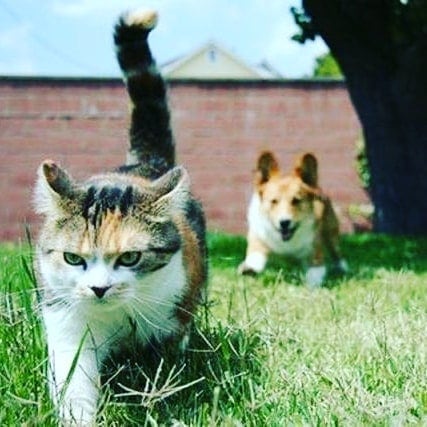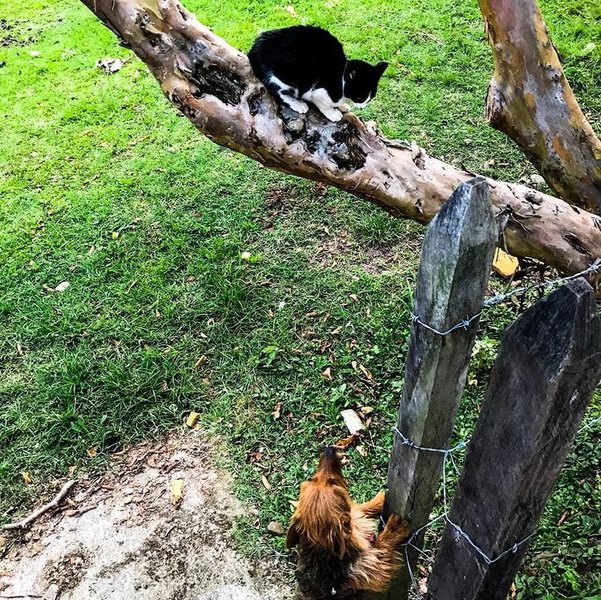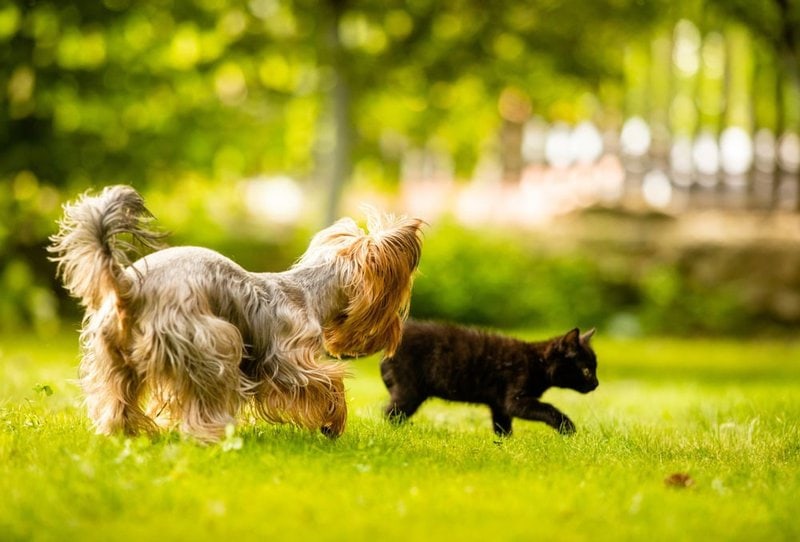The tale of enmity between dogs and cats is one that is as old as time, and this begs the question of why dogs can’t seem to stop chasing after cats.
So, why do dogs chase after cats? Dogs chase after cats either because their natural prey drive has been triggered, as an aggressive response to stress triggers, an attempt to play with the cat, or due to the cat encroaching on the dog’s perceived territory.
Cat chasing is mostly an instinctive behavior for dogs, but as inferred by the answer paragraph, there are situations where this behavior can be motivated by other reasons, some more serious than others.
Fortunately, there are some training techniques you can employ to get your dog to stop chasing after your kitty, and we have outlined a few of the most effective ones in this article. However, before we go into all that, let’s take a detailed look at why dogs chase after cats.
Why Do Dogs Chase Cats?

Common reasons for dogs chasing after cats include an instinctive drive, territorial issues, and redirected aggression caused by stress. It is also essential to establish that dogs don’t chase cats out of hate.
High Prey Drive
Most times, the reasons behind a dog chasing a cat are purely instinctive and due to an underlying high prey drive.
Most dogs have innate hunting instincts, which can be traced back to their wolf ancestry or history as hunting dogs. And it is this instinct to chase and hunt down that is triggered when such dogs come across small furry animals like cats.
That said, this prey drive is more likely to kick in when the pooch is outdoors, as this resembles a natural hunting habitat, thereby making it seem right to give chase.
Play Behavior
Chasing a cat by a dog doesn’t necessarily indicate prey hunting activity, and it can just be that the pooch in question is looking to play.
However, regardless of your Fido’s playful intentions, your cat may not appreciate the pooch’s method of approach, and as a result, the feline will always scamper off when the dog makes moves to play with it.
Territorial Issues
Dogs are quite territorial by nature and also fiercely protective of their favorite toys or household items. And if a pooch feels that the house cat is encroaching on its perceived personal space or favorite toys, a chase may ensue.
Chases inspired by territorial issues can get pretty serious, and if your pooch tends to act this way, it is vital that you address the issue as soon as possible before your kitty gets injured during such chases.
Stress
Dogs, like humans, can also experience stressful situations, and if a cat is unlucky to be around at that moment, it may likely become the subject of an unpleasant chase.
Situations that can induce stress in dogs include sudden loud noises, unfamiliar and unpleasant scents, meeting new people, separation anxiety, and physical discomfort, just to mention a few.
What Dog Breeds Are More Likely To Chase Cats?
Having established that dogs mostly act on their natural prey drive when chasing after cats, it is imperative to note that some dog breeds have higher prey drives than other pooches; Hence, these dogs with a higher prey drive are more likely to chase after cats than other pooches with a low prey drive.
That said, some of the dog breeds have a high prey drive, and which you can expect to occasionally give your cat a chase around the yard include:
- German Shepherds
- Golden Retrievers
- Greyhounds
- Siberian Huskies
- Jack Russell Terriers
- Doberman Pinschers, and
- Border Collies, just to mention a few
How Do I Get My Dog To Stop Chasing My Cat?
You can get your dog to stop chasing after your cat by training the pooch, properly introducing new pets to each other, or by employing the services of a qualified animal trainer to help curb your pooch’s aggression.
Undeniably, the most effective means of ensuring that your dog won’t chase after your cat is by raising them together from when they are little. However, in situations where this isn’t possible, here are some steps you can take to ensure peaceful coexistence between Fido and Kitty.
Training
Obedience training is one way to instill good manners in dogs, and it is equally effective at getting dogs to stop chasing after cats.
There are several training methods you can employ to get your pooch to stop chasing after your cat, but one method that has proven to be particularly effective is attention redirection, and the idea behind this is simple:
- Immediately you notice your pooch making attempts to chase after the cat, turn the dog’s attention towards you – this can either be by calling out the pooch’s name or making a noise.
- Ensure you’re holding a toy or treat in hand when distracting the pooch and only offer these to the dog after you have successfully diverted its attention.
Alternatively, if you’ve taught your pooch the ‘leave it!’ command, you can also make use of this in getting your canine buddy to stop chasing after the cat, and this is typically done as follows:
- When you observe your pooch making life difficult for the cat, use your ‘leave it’ cue to get the dog to stop disturbing the cat.
- Immediately your dog loses interest in the cat, command the pooch to watch you.
- Offer a treat or toy every time the dog obeys your command.
- With time, the pooch will start looking at you whenever the cat is passing in the hopes of earning a reward.
If, however, you’ve not taught the ‘leave it’ or ‘watch me’ commands to your dog, it’s never too late to do so. And you can check out these AKC guides on teaching your dog the ‘leave it’ commands and how to effectively grab your pooch’s attention in any situation.
Points To Note
- During the training period, make sure the dog and cat aren’t left together unsupervised.
- Ensure the dog is always leashed around the cat during the training period.
- Closely monitor interactions between both pets during the training; If you notice any signs of hostility or of the pooch reverting to its chasing behavior, restart the training from the beginning.
- Always offer rewards in the form of praise and treats whenever the dog manages to stay calm in the presence of the cat.
Properly Introduce New Pets To Each Other
If you’re bringing a new cat into a home already containing a dog or vice versa, then it is imperative that you take steps to properly introduce both pets to each other. A proper introduction is essential to ensure peaceful coexistence between both pets and avoid occurrences of the dog chasing the cat.
That said, here is a brief outline of how you should properly introduce Fido to the new cat:
- When bringing a new cat or dog into your home, don’t immediately introduce both pets to each other.
- Keep the dog and cat apart for the first few days while giving them a chance to roam restricted areas of the home, thereby experiencing each other’s smells and sounds.
- Build positive associations between pets by placing clothes and toys containing their respective smells beside their food dishes.
- After carrying out the step detailed above for a few days, try feeding both the dog and cat together, with a closed door separating both of them; Ensure the food dishes are as close to the door as possible.
- The first physical meeting between the dog and the cat should be done in a room with a baby gate or screen door; This helps make it easy to control possible aggression.
- Ensure the meeting is carried out in a neutral location rather than in the dog or cat’s favorite room.
- You can also keep the dog attached on a leash to prevent attacks on the cat.
- Keep meetings short and brief.
- Continue offering treats to both the dog and cat whenever they meet each other. This helps both pets build positive associations with each other.
- Carry out the aforementioned steps until the dog and cat begin to behave appropriately in each other’s presence, and even then, continue to monitor interactions between both pets.

Modify Your Environment
You can help your cat escape attacks from the dog by arranging home furniture in a way that makes it difficult for the pooch to give chase.
Additionally, you can provide your cat with a safety zone – preferably a perch that the dog can’t access – that the feline can safely retreat to whenever it is attacked by the dog.
Provide Adequate Exercise For The Dog
Stress or boredom-motivated chasing by dogs can be controlled by giving the pooch appropriate outlets to release excess energy.
These outlets can be in the form of physical exercises such as swimming, playing games such as fetch, running around the yard off-leash, or playing with a dog friend.
Mental exercises like food puzzles, learning tricks and basic dog cues also provide an effective means for bored dogs to let out energy.
Get Professional Help
If, after implementing any of the steps outlined above, you notice that your dog’s tendency to chase after cats persist, you should consider getting the help of an animal behavioral specialist to counter the problem.
In this case, chasing after cats, and fast furry animals in general, may have developed into some sort of compulsive disorder for the pooch, and advanced training will be needed to help the pooch overcome this habit.





